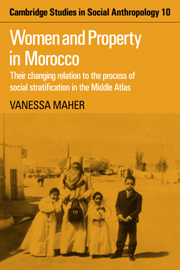 Women and Property in Morocco
Women and Property in Morocco Book contents
- Frontmatter
- Contents
- List of tables
- List of illustrations
- Preface
- Note on orthography
- Map of the Akhdar region
- Introduction
- 1 The background
- 2 Estates, tribal groups and the market today
- 3 Patron-client relations
- 4 How it looks on the ground
- 5 The cultural corollary: education and social stratification
- 6 Religion and social stratification
- 7 Conjugal roles, kinship roles and the division of labour
- 8 Relationships among women
- 9 Fostering
- 10 Marriage
- 11 Marriage and the market
- 12 The position of the bride after marriage
- 13 Divorce and property
- Conclusions
- Glossary
- Select bibliography
- Index
11 - Marriage and the market
Published online by Cambridge University Press: 27 October 2009
- Frontmatter
- Contents
- List of tables
- List of illustrations
- Preface
- Note on orthography
- Map of the Akhdar region
- Introduction
- 1 The background
- 2 Estates, tribal groups and the market today
- 3 Patron-client relations
- 4 How it looks on the ground
- 5 The cultural corollary: education and social stratification
- 6 Religion and social stratification
- 7 Conjugal roles, kinship roles and the division of labour
- 8 Relationships among women
- 9 Fostering
- 10 Marriage
- 11 Marriage and the market
- 12 The position of the bride after marriage
- 13 Divorce and property
- Conclusions
- Glossary
- Select bibliography
- Index
Summary
In this chapter it becomes clear that women play the major part not only in choosing brides for their kinsmen and acquaintances, but in carrying out the marriage rituals. This is because a girl's change in status has far-reaching implications for her female network, but a man's relationships are not affected by his marriage to nearly such an important extent. This is not to say that they remain the same but that his relations with men and with women too are governed more by his achievements in the public sphere, and his position in the labour market, than by his ascribed status. It is noteworthy, in this connection, that in the countryside, where a man's marriage means that he can set up a household which is viable in terms of labour resources, it also implies a new independence of his kin. Significantly, men participate very actively in rural weddings.
After an account of a townsman's betrothal to a ksar-girl, I discuss town marriages of various kinds, concentrating on the significance of dower as the mark of Arab status and economic autonomy. Dower entitles a man to replace his wife's kin with his own. For this reason, soldiers are generally unacceptable as husbands and affines, because a girl and her kin do not know whether, marrying a soldier, she is actually acquiring a respectable kin-group or simply being deprived of her own, for she will inevitably leave the area.
- Type
- Chapter
- Information
- Women and Property in MoroccoTheir Changing Relation to the Process of Social Stratification in the Middle Atlas, pp. 163 - 179Publisher: Cambridge University PressPrint publication year: 1975
